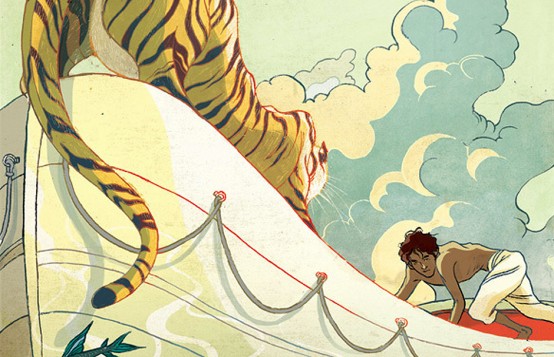[sws_blockquote_endquote align=”” cite=”Rachard Brody – The New Yorker” quotestyle=”style03″] Ang Lee wants to honor Yann Martel’s tone in the prize-winning 2001 novel, “Life of Pi,” as well as his narrative strategy, but perhaps filmmakers should stop using India as a source of higher spirituality — it’s a genteel form of exploitation and one that’s increasingly misleading. Where is the surging, high-tech, entrepreneurial narrative of the past twenty years? [/sws_blockquote_endquote]
Welcome to Pi’s Ark! and soon enough Pi and a four hundred and fifty pound Bengal Tiger – a digital beast – are the only passengers aboard a safety boat in the middle of the South Pacific Ocean.
Pi’s family owned a zoo and had decided to move with some of the animals from India to Canada. But a storm wrecks the old Japanese freighter carrying them. The animals are washed out of the hold and flail around in the tumultuous seas. Pi falls into a lifeboat, and popping out from beneath a canvas covering, a tiger who owing to a clerical error, would be called Richard Parker.
The movie becomes a survivalist mini-epic, in the spirit of Robinson Crusoe. Desperate ingenuity and sheer reflex lead one memorable scene to another.
It is an improbable story however; and we are meant to see it as a fable. Ang Lee of “Crouching Tiger, Hidden Dragon” and “Brokeback Mountain” fame, has filmed it with so much moment-by-moment physical detail and so bounteous a celebration of the natural world that Life of Pi could become one of the great adventure films.
You can’t fight the kind of overwhelming sensuous feat that is possible in the cinema; you just let it sweep you away, as the yawning chasms and purple-and-green forests of “Avatar” did.
Pi is a bold youth, an experimenter, who was almost promiscuous in his religious appetites – he was once a Hindu, but took up Christianity and then Islam. That his father was tough and disapproved of his son’s curiosity is an understatement. His mother, on the contrary, fed his imagination.
This part of the story is sweet tempered but overly methodical, even ponderous, a product of Lee’s determination to pay utmost respect to a culture different from ones to which he’s more accustomed.
The movie never anthropomorphizes the tiger – Richard Parker is a member of a different species; he’s not mistaking that; he’s not interested in affectionate ties with a skinny teen-ager who has kept him from dying. That’s genuine and bracing insight.
And there’s more – the boy’s search for God and other mighty significances lay indelible beneath the picturesque moments. Secularist audiences may in general find trouble with this approach or “quest,” in which meaning is somehow sought and wrestled from the teeming universe.
The assertion that there are many searches, many meanings, most of them partial, is perhaps true. As Wallace Shawn said thirty years ago, in My Dinner with André, something no more miraculous than a cup of coffee is enough transcendence for one day.
But that would take too much away from Life of Pi, which at its best, beyond celebrating the idiosyncratic wonders and dangers of raw, ravaging nature, also wrings enough meaning from the excitement; we certainly needed something higher to come away with.
Director: Ang Lee
Writers: David Magee (screenplay), Yann Martel (novel)
Stars: Suraj Sharma, Irrfan Khan and Adil Hussain










